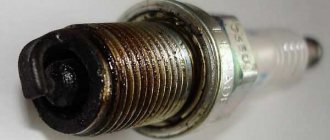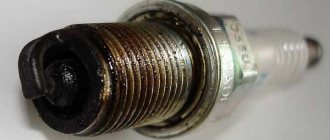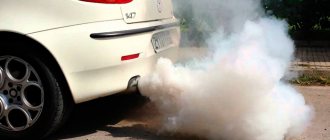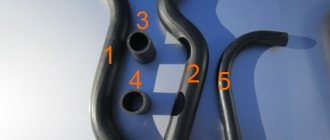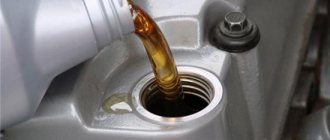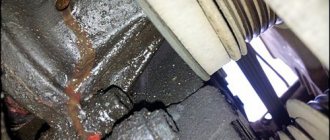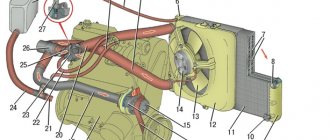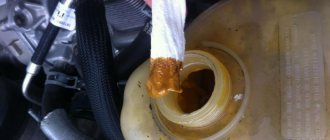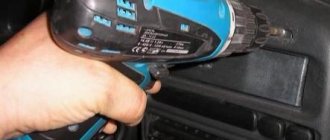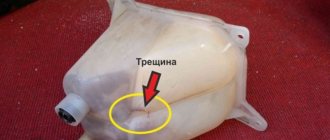It is no secret that for normal operation, an engine requires fluid, or rather fluids, such as motor oil, coolant (antifreeze, antifreeze or water), as well as fuel, due to which the power stroke occurs. I will not go into detail about the role played by each of the above liquids; I think everyone already knows about this to one degree or another. Instead, I want to talk about mixing these liquids, why this happens, what the dangers are and how to avoid this.
Antifreeze in oil - consequences
Such a problem as antifreeze in oil or oil in antifreeze is always unpleasant and always fraught with big troubles. Now you’ll find out which ones. Getting antifreeze into the oil is unacceptable for the reason that any oil has its own viscosity, as well as the necessary set of additives that ensure lubrication of rubbing parts and protect them from corrosion. When antifreeze gets into the oil, it dilutes it, impairing the lubrication of parts and increasing their wear. The appearance of antifreeze in the combustion chamber or oil system can lead to the formation of soot or deposits, which over time will negatively affect the operation of the power unit.
Antifreeze or antifreeze in the oil can also lead to oil starvation by clogging the filter elements, which ultimately impedes the flow of oil into the oil system.
In addition, there is another “side of the coin” - the likelihood of engine overheating due to a decrease in the coolant level. A decrease in the coolant level below the permissible level makes the cooling of the power unit less effective, which can result in engine overheating.
Oil cooler failure
An oil cooling system is necessary for a car to maintain the lubricant at a temperature that is comfortable for the car to operate. If the oil cooler tubes are damaged and this system depressurizes, oil gradually begins to leak into the coolant. The first signal that the problem with your breakdown is in the oil cooler is the appearance of oil with bubbles in the coolant.
In this case, it is necessary to remove the pipes from the oil cooler, wash them and connect them together. The expansion tank of the system also needs to be completely cleaned. After these manipulations, the liquid is refilled. After a short period of time after restarting the car, you need to check whether the problem has disappeared or not. If yes, then the repair will cost you a little less, since you will have to deal exclusively with the cooler.
The coolant reservoir is dirty with grease
After removing the cooling system, you should thoroughly check all the pipes and, if there are cracks, weld them. This part of the work should be left to professionals. Poor quality repairs will end up costing you even more. Most often, copper tubes of the appropriate diameter are simply inserted into the places where cracks form in the oil cooler.
Sometimes oil gets into the antifreeze due to the fault of service station employees. If you discovered such a problem after visiting the station, it is worth checking whether engine oil has been added to the cooling system of your car. To do this, the liquid from the oil cooler is completely drained, and the system itself is thoroughly washed. In the final part of the work, you just need to pour new antifreeze into the engine.
Be sure to note that passenger cars have an oil heat exchanger filter. If a malfunction of the engine circuit in question is diagnosed, the filter must also be replaced.
How to detect coolant in oil
The easiest way to detect antifreeze in oil is by reducing the coolant level in the system. If the antifreeze level drops, but there are no leaks anywhere, you should check the oil level, as well as its color and condition, perhaps the antifreeze has gone into the oil.
When checking the engine oil level, it is not difficult to see the antifreeze; it will have a lighter color and will be located above the oil level, and the antifreeze itself will quickly flow down the oil dipstick. Due to dilution with antifreeze, the color of the oil will change towards the color of the coolant.
The second option for checking and detecting antifreeze in oil is the expansion tank. It is necessary to start the engine and increase the speed, while you need to open the tank and see if there are any air bubbles in it. Also, if there is antifreeze in oil or oil in antifreeze, traces of oil will be visible on the walls of the expansion tank. If antifreeze gets into the oil, then after some time the color of the antifreeze itself will also change.
Candles. If antifreeze gets into the oil, the candles will also have soot or a characteristic shade of antifreeze.
When antifreeze gets into oil or oil gets into antifreeze, the color of the exhaust will change; it may become thicker and more concentrated.
Relevant: The engine is taking oil, but you don’t know what’s wrong? We will tell you why the engine consumes oil!
Signs of antifreeze getting into car oil
How to determine that antifreeze has entered the lubricant complex? This can be understood by the following signs:
- The amount of lubricant has increased and the coolant level has decreased. If the expansion tank quickly empties without leaks, look at the dipstick. Most likely, the liquid has already gone beyond the maximum src=»https://motoroill.ru/wp-content/uploads/2017/04/bachok-tosola.jpg» class=»aligncenter» width=»650″ height=»492 ″[/img]
- The shade of the grease changed from brown to darker. Pay special attention to this sign if you recently changed the oil product.
- Car oil has a heterogeneous consistency. Interacting with the coolant, the oil liquid becomes like an emulsion.
- The color of the exhaust has changed. When the coolant burns, the exhaust gases become light-colored. In summer, this sign is impossible not to notice.
- The functioning of the power unit has deteriorated. It begins to “triple”, as the emulsion clogs the oil channels and interferes with the proper operation of the engine.
If you find that the coolant is leaking into the lubricant, turn off the engine and find out the cause of the leak. Otherwise, you may have to overhaul your internal combustion engine.
How does antifreeze get into the oil?
Cylinder head (cylinder head). The first thing that happens on the cylinder head is that the gasket can burn out. If the cylinder head gasket is leaking on the inside, you can tell by the color of the exhaust and corrosion in the cylinder liners. If the gasket burns out from the outside, then a characteristic leak will be visible on the block.
Oil in antifreeze may also appear due to the appearance of microcracks in the cylinder block, or as a result of deformation of the cylinder head. The latter can be caused by several reasons, for example, engine overheating or long service life.
Why is this happening
There are different signs: damage to the oil cooler or a problem with the cylinder head. Contact between the cooling and oil systems occurs only at these points. Some cars need to maintain a specific oil temperature
from seventy-five to eighty-five degrees. Such vehicles are equipped with an oil cooler that interacts with the cooling system, and the coolant is antifreeze.
Oil in the antifreeze indicates that you will need to sort out the oil cooler and fix the problem, or you will have to change everything completely. Lubricating properties are lost, a large load is placed on the engine, which eventually fails. The antifreeze composition contains glycol with toxic indications, so when it gets into the engine lubricant, the potential is destroyed. This leads to blockage of oil molecules and lubricating properties.
Causes and solutions to the problem:
- the head gasket is broken - remove the head and replace the gasket;
- deformation of the head plane – grinding (milling work);
- Poor tightening of bolts - tighten using a torque wrench;
- microcrack in the cylinder block - repair with epoxy paste, clean the surface, weld, weld steel.
The reason for oil getting into the antifreeze is a burnt gasket or a faulty cylinder head itself. This problem comes up when drivers start checking the fluid level. The color and thickness of the coolant changes, the refrigerant develops a pungent odor
. This is the “first call” for the car driver.
Today, ethylene glycol is used as a base for coolants. It is diluted with water in certain proportions, but has the disadvantage of toxicity.
Propylene glycol liquids have a lower boiling point, but better quality, although their production requires more costs.
If the system depressurizes or the pipes are damaged, the engine fluid instantly ends up in the cooling system and vice versa. There are many factors that cause this problem. One of the most important is the inadequacy of the refrigerants used by the driver of the vehicle.
How to prevent oil from getting into antifreeze or antifreeze from getting into oil?
Regular full monitoring of the level of liquids, as well as their color and condition, will allow you to avoid troubles such as oil in antifreeze or antifreeze in oil. Timely detection of a breakdown will not only save on repairs, but also minimize its consequences. If you do not have the opportunity or the necessary skills to independently determine whether there is antifreeze in the oil or not, as soon as the first symptoms appear, I recommend contacting a service station with professionals who will help you in this matter.
Elimination method
When a significant amount of lubricant gets into the antifreeze, the latter is unable to work as a coolant. It forms clots and even solid particles that settle on the walls of the channels, clogging the thermostat valve and clogging the radiator. There is also no guarantee that mutual penetration has not occurred and antifreeze has not leaked into the oil pan. Hence the conclusion: both liquids must be drained .
If your car is equipped with an oil cooler, immediately contact a service station to locate the broken gasket. Then decide whether to carry out the repairs yourself or entrust the work to car service personnel.
What to do if oil or emulsion is found in the expansion tank with antifreeze:
- Both systems need to be flushed. Before draining the antifreeze, add a special detergent composition to the expansion tank and let the engine idle for 5 minutes. Empty the lubrication system immediately.
- Unscrew and discard the oil filter.
- Replace the gasket on the cylinder block by removing the cylinder head. During the dismantling process, disassemble the elements of the cooling system (pipes, pump, thermostat) and thoroughly rinse them by hand. Do the same with the heat exchanger if it is the culprit for mixing liquids.
- Unscrew the oil pan and oil pump, disassemble the latter and change all gaskets. Before assembly, wash the parts with gasoline or solvent.
- Assemble the power unit, install a new filter and fill in engine flushing lubricant. Instead of antifreeze, fill the system with distilled water and add detergent.
- Start the engine and let it run for 10–15 minutes without increasing the speed. Keep an eye on the oil warning light and temperature gauge.
- When finished, replace the water with a working fluid - antifreeze, and the flushing oil - with full-fledged engine oil. It is highly advisable to change the filter twice.
Advice. When pre-flushing the cooling system before eliminating the malfunction, monitor the temperature and pressure of the lubricant. If you notice something is wrong, immediately turn off the engine, as the oil still gets into the antifreeze.
No matter how carefully you try to wash the engine parts during disassembly, you will not be able to get to all the channels. Therefore, flushing is performed several times, including after starting the power unit. During further operation, monitor the condition of the process fluids so that the problem does not recur.
Problem Definition
It can be quite difficult to determine with accuracy why oil gets into the antifreeze. Basically, this problem is identified by white smoke from the exhaust pipe. The quality of the oil is of great importance. If the oil dipstick has a white coating, this indicates the presence of this problem. The best solution for drivers is, of course, to turn to specialists
. To identify the problem, use a special luminous additive. It helps to determine the exact locations of cracks, depressurization and other deficiencies. When the problem cannot be solved in this way, the entire cooling system and some engine parts are gradually disassembled. All parts undergo diagnostics for all kinds of breakdowns and malfunctions.
